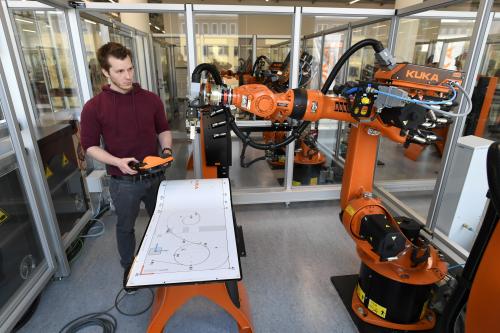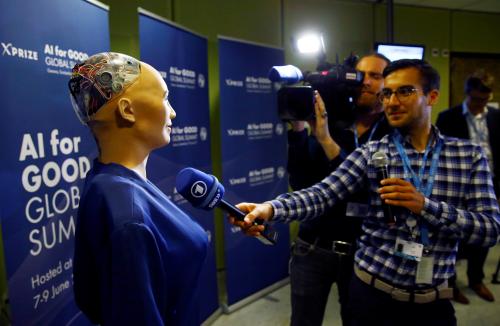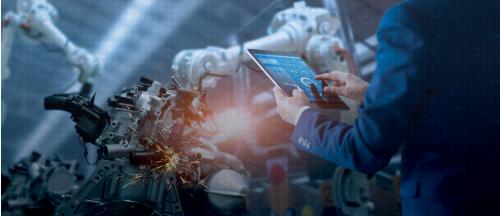The rise of cognitive computing systems (CCSs) brings a potentially massive shift in the way that work is done, which could lead to an equally massive displacement of the workforce. Advanced automation is already reshaping low-skill and even medium-skill jobs, and tasks once done by so-called ‘knowledge workers’ are now done by machines (think of financial services). Given that up to 47 percent of current jobs are likely to be automated by 2034, this suggests massive labor market upheaval. Additionally, the Obama White House estimated that 83 percent of workers making less than $20 per hour are likely to lose their job due to automation. In short, it doesn’t take a crystal ball to see the potential for significant job displacement, particularly of low- and middle-skilled workers.
While the public sector lags the private sector in the adoption of innovation in general, the public sector adopts innovation as rapidly as the private sector in some cases. We already see evidence of the public sector adopting advanced automation: Hong Kong’s Immigration Department uses AI algorithms to sort visa, passport, and residency applications. The algorithms scan and sort each application into one of three categories: clearly approved, clearly denied, or uncertain. A visa officer then reviews the material and makes a decision. Singapore’s government deployed a virtual assistant – ‘ask Jasmine’ – to reduce the number of calls to the customer centers. Further, residents and businesses in Singapore can utilize ‘ask Jasmine’ to file tax returns.
Many focus on the potential of these technologies to augment the capabilities of human workers. For instance, American Express and Procter & Gamble are investing in cognitive computing systems to improve business operations, but are not planning to eliminate employees. Both companies view these machines as job enhancements and not replacements, stressing the importance of augmentation over automation. The companies believe cognitive computing will result in business growth and create more jobs. While these technologies will initially augment work, they will no doubt eventually replace human workers. For example, the private sector is experimenting with “chatbots”, a form of AI, to automate and replace customer service workers. Steve Nichols, Georgia’s chief technology officer, quickly pointed out that Georgia’s Department of Human Services could use these same chatbots to respond to the routine questions asked of human services employees.
Today, AI has already mastered bluffing, a trait that some might argue is deeply human. Researchers from Carnegie Mellon University developed an AI system called Libratus that won $1,766,250 by defeating the world’s best poker players. Until now, machines could beat humans when it came to games where all players have perfect information, such as chess. Now machines can work with imperfect information and strategically deceive their opponents. Looking to the future, one can expect that these AI will increase in sophistication. Consider the recently released AutoDraw tool from Google that uses AI to guess the subject of a drawing and then complete it. Researchers and technology enthusiasts are working feverishly to build systems that can mimic some of the most deeply human traits from creativity and empathy.
Recently, pundits from all sectors have examined the economic impacts of greater automation through one of the first examples of CCSs – robots. Bill Gates has argued that robots should incur a tax at parity with the workers they replace. If a robot replaces a worker who makes $50,000 annually, the robot would be taxed at the same $50,000 income level and the tax revenue would be used to retrain the displaced worker. While this makes intuitive sense, the idea has its critics. Lawrence Summers, former Director of the National Economic Council under President Obama, makes the case that taxing technology may create a disincentive for companies to further invest in research and development for their systems, leading to an aggregate decrease in innovation that would negatively impact society at large.
Evidence from the public and private sector portend a greater adoption of AI. In the public sector, this has the power to significantly enhance government’s service to citizens. In addition, AI holds the potential to displace low- and middle-income workers in substantial numbers. This disruption requires holistic thinking about consequences across the entire social, political, and economic ecosystem. Towards this end, the U.S. must consider modernizing its higher-education systems to prepare the workforce for this possibility. It is important for policymakers to plan for a new economic system where machine-to-machine interactions fundamentally alter the nature of work, the design of organizations, and the execution of transactions.








Commentary
Disrupting work and workers in the age of cognitive computing systems
April 26, 2017